- 999 views
- 0 comments

Yellow sapphire has captivated hearts for centuries and it is known for its vibrant hue and stunning beauty. In this blog post, we will write about the origins of yellow sapphire, exploring where it comes from and its significance in various cultures. This gemstone carries stories of power, wisdom, and protection from ancient traditions to modern jewelry. Join us as we uncover the fascinating journey of yellow sapphire through time and its place in our lives today.
GEOLOGICAL FORMATION OF YELLOW SAPPHIRE
Yellow sapphire forms deep within the Earth under intense heat and pressure. These gemstones are a type of corundum, which is a mineral made of aluminum oxide. The vibrant yellow color comes from trace amounts of iron within the crystal structure. Millions of years ago, geological activities such as volcanic eruptions and tectonic movements created the perfect conditions for yellow sapphire to form. These processes pushed minerals together, allowing crystals to grow slowly over time.
It's fascinating to think that what we now admire in jewelry was once hidden beneath layers of rock and soil, waiting to be discovered. When we write about the geological formation of yellow sapphire, it's important to remember that these gems are not just beautiful but also natural wonders. Their formation is a testament to the incredible forces of nature that shape our planet.
HISTORICAL SIGNIFICANCE OF YELLOW SAPPHIRE
Yellow sapphire has been cherished throughout history for its beauty and is believed mystical properties. Ancient cultures, especially in India, have valued yellow sapphires, often associating them with Jupiter, the planet of wisdom and prosperity. Kings and queens would adorn themselves with yellow sapphires, believing the gems could bring them wealth and protect them from harm. In ancient Greece and Rome, yellow sapphires were thought to bestow wisdom upon their wearers. Scholars and philosophers would often keep these gems close, hoping to enhance their mental clarity and knowledge.
Throughout the Middle Ages, yellow sapphires continued to be a symbol of power and protection, often set into crowns and royal jewelry. In many cultures, yellow sapphires were also considered a token of love and commitment. They were used in engagement and wedding rings to symbolize a prosperous and harmonious union. This historical significance of yellow sapphire still resonates today, as the gem remains a popular choice for those seeking both beauty and meaning in their jewelry.
MAJOR MINING LOCATIONS AROUND THE WORLD
.webp)
• SRI LANKA - Often considered the premier source for high-quality natural yellow sapphires. The region around Ratnapura, also known as the "City of Gems," is especially famous for producing stunning stones.
• MYANMAR (BURMA) - Known for its rich deposits of various gemstones, including yellow sapphires. The Mogok Valley, in particular, is renowned for yielding some of the world's finest sapphires.
• MADAGASCAR - A relatively newer player in the gemstone market, Madagascar has quickly gained a reputation for its high-quality yellow sapphires. The island's Ilakaka region is a hotspot for sapphire mining.
• THAILAND (BANGKOK) - Not only a hub for gemstone trading, but Thailand also has its sapphire mines, especially in the Chanthaburi and Kanchanaburi regions. These areas are well-regarded for their vibrant yellow sapphires.
• AUSTRALIA - The sapphire fields of Queensland produce a variety of sapphires, including yellow ones. Australian yellow sapphires are known for their unique, often golden-yellow hues.
• TANZANIA - While more famous for its tanzanite, Tanzania also produces yellow sapphires. The mining area around Tunduru has yielded some impressive finds.
THE ROLE OF YELLOW SAPPHIRE IN ASTROLOGY AND HEALING
Yellow sapphire has a special place in astrology and healing practices. Often linked with the planet Jupiter, this gemstone is believed to bring wisdom, prosperity, and good fortune to its wearer. Many people wear yellow sapphires to enhance their career prospects, attract wealth, and gain success in their endeavors.
In addition to the astrological benefits of yellow sapphire, it is also said to have healing properties. It is thought to strengthen the immune system, improve digestion, and aid in treating ailments related to the liver and pancreas. Some believe that yellow sapphire can help balance the mind and emotions, reducing stress and anxiety. Healers often recommend yellow sapphire for individuals seeking mental clarity and spiritual growth. The gemstone is said to open up the mind to new possibilities and foster a sense of optimism. By aligning the energies of the body and mind, yellow sapphire helps individuals achieve a harmonious and balanced state of being.
IDENTIFICATION AND GRADING OF YELLOW SAPPHIRES
To identify and grade yellow sapphires, gemologists look at several important factors. Let's break down the key aspects to help you understand how to check the quality of a Pukhraj:
• COLOR - The most prized yellow sapphires have a vibrant, pure yellow hue without any brown or green tints. The color should be evenly distributed throughout the stone.
• CLARITY - High-quality yellow sapphires have few to no visible inclusions. Inclusions are tiny flaws inside the gem, and fewer inclusions generally mean a higher grade.
• CUT - The cut of a yellow sapphire affects its brilliance and overall appearance. A well-cut sapphire will reflect light beautifully, making it sparkle. Poor cuts can make even the best-colored stones look dull.
• CARAT WEIGHT - Like all gemstones, the weight of a yellow sapphire is measured in carats. Larger stones are rarer and usually more valuable, but a smaller, high-quality gem can be worth more than a larger, lower-quality one.
• ORIGIN - The source of the yellow sapphire can also affect its value. For example, sapphires from Sri Lanka are often highly regarded for their quality.
• TREATMENT - Many yellow sapphires undergo treatments to enhance their color and clarity. Heat treatment is common and generally accepted, but untreated yellow sapphire are rarer and often more valuable.
By considering these factors, you can better determine the quality of a yellow sapphire and make an informed purchase.
ETHICAL CONSIDERATIONS AND SUSTAINABLE MINING PRACTICES
Ethical considerations and sustainable mining practices are crucial in the gemstone industry. When we write about this topic, it's important to emphasize that responsible mining helps protect the environment and supports local communities. Many yellow sapphire mines now focus on reducing their environmental impact by using less water, minimizing waste, and avoiding harmful chemicals. In addition to environmental practices, fair labor conditions are vital.
Ethical mining ensures that workers receive fair wages, work in safe conditions, and are not subjected to child or forced labor. Supporting mines and companies that adhere to these principles helps promote social and economic well-being in mining regions. Consumers also play a role by buying from reputable sources and prioritizing ethical practices. By demanding transparency about the origins and mining methods of yellow sapphires, we can contribute to a more sustainable and fair gemstone industry.
BEST SOURCE OF YELLOW SAPPHIRE
Regarding the best source of yellow sapphire, Sri Lanka, also known as Ceylon, stands out. The island nation is famous for producing some of the highest-quality yellow sapphires in the world. But why is Srilankan (Ceylon) pukhraj more expensive than others? The answer lies in their exceptional color, clarity, and overall quality. Ceylon yellow sapphires often have a vibrant, pure yellow hue that gem enthusiasts and collectors highly prize. Apart from Sri Lanka, other countries also produce beautiful yellow sapphires, but they are often compared to the superior quality of Ceylon sapphires. Factors like the mining conditions, the expertise of local gem cutters, and the natural geological features of Sri Lanka contribute to the unmatched beauty of its yellow sapphires. When buying yellow sapphire, knowing its origin can give you confidence in its quality. Sri Lankan pukhraj are renowned for their beauty and are often considered a worthwhile investment.
Yellow sapphires are truly remarkable gemstones with a rich history and unique geological formations. From their origins in countries like Sri Lanka, Myanmar, and Madagascar to their significance in astrology and healing, yellow sapphires continue to fascinate and enchant people worldwide. Whether for their aesthetic appeal or their mystical properties, yellow sapphires hold a special place in the hearts of many.
Are you looking to buy a stunning yellow sapphire? Browse our site NaturalPukhraj.com, where we offer 100% certified and original pukhraj. Our gems come with a buy-back guarantee, ensuring you can purchase with confidence. Each sapphire is carefully inspected for quality, so you know you're getting a genuine gemstone. Whether you're seeking a yellow sapphire for its beauty or its astrological benefits, we have a wide selection to meet your needs. Plus, with our easy-to-navigate website, finding the perfect yellow sapphire has never been simpler. Shop now at NaturalPukhraj.com and discover the best in certified yellow sapphires.
Shop Natural Yellow Sapphire from Ceylon
More From our journal
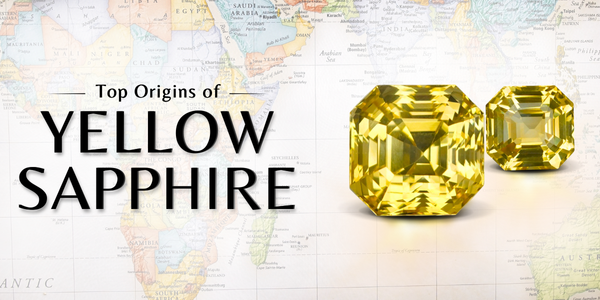
ORIGINS OF YELLOW SAPPHIRE
Yellow sapphire, known for its vibrant hue and stunning beauty, has captivated hearts for centuries. In this blog post, we will write about the origins of yellow sapphire, exploring where it comes from and its significance in various cultures. This gemstone carries stories of power, wisdom, and protection from ancient traditions to modern jewelry. Join us as we uncover the fascinating journey of yellow sapphire through time and its place in our lives today.
Read more
WHAT ARE THE SIDE EFFECTS OF WEARING YELLOW SAPPHIRE?
Many people believe that yellow sapphire can bring luck, prosperity, and good health. However, it’s important to consider that wearing this gemstone might not be suitable for everyone. Some individuals may experience negative effects when wearing yellow sapphire. In this blog post, we will explore the question, "What are the side effects of wearing yellow sapphire?" and help you understand if this beautiful stone is right for you. Let's dive into the potential harms of yellow sapphire and what you should keep in mind before making it a part of your jewelry collection.
Read more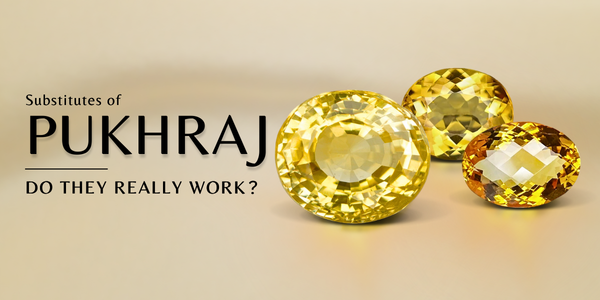
IS YELLOW SAPPHIRE'S ALTERNATIVE STONE WORK?
Regarding gemstones, Yellow Sapphire holds a revered place in the world of astrology and healing. However, many enthusiasts are curious about alternatives that can deliver similar benefits. This blog post will explore the question, "Is Yellow Sapphire's Alternative Stone Work?" While some believe alternatives can mimic its properties, others argue that the unique vibrational energy of Yellow Sapphire is irreplaceable. Join us as we delve into the merits and limitations of using alternative stones in place of this cherished gem.
Read more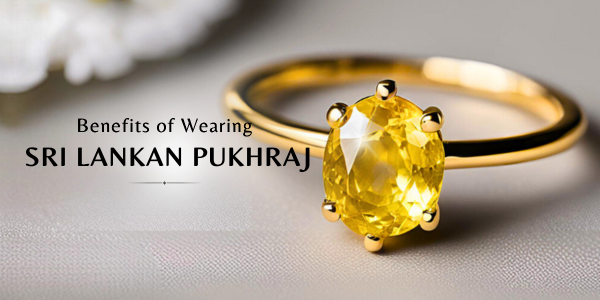
BENEFITS OF WEARING SRI LANKAN PUKHRAJ
Welcome to our blog post about the benefits of Sri Lankan Pukhraj! This precious gemstone, also known as yellow sapphire, is highly revered in the world of gemstones for its numerous benefits and properties. In this post, we will dive deeper into the origins of Sri Lanka Pukhraj, its unique qualities, and the various ways it can positively impact your life. Whether you are a gemstone enthusiast or simply curious about this beautiful gem, we invite you to join us on this journey as we explore the wonders of Sri Lanka Pukhraj.
Read more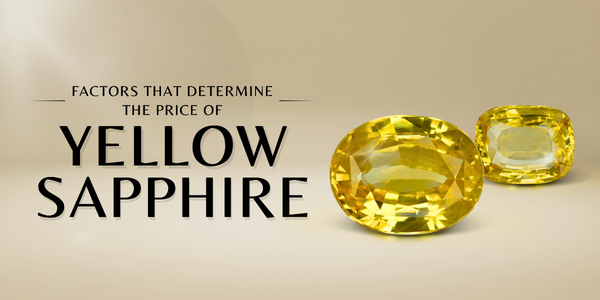
FACTORS THAT DETERMINE THE PRICE OF A YELLOW SAPPHIRE
Natural yellow sapphires are one of the most sought-after gemstones due to their stunning color and rarity. However, their price can vary greatly depending on various factors. In this blog post, we will explore the factors determining the price of a natural yellow sapphire. We will answer the question that many gemstone enthusiasts have been asking: "How much does a natural yellow sapphire cost?" We will break down the various elements that influence the price of this beautiful gemstone and provide valuable insights for those looking to invest in one.
Read more
WHICH STONE IS GOOD FOR GURU OR JUPITER?
Welcome to our blog post about the Jupiter Stone! As the largest planet in our solar system and the planet of luck, expansion, and growth, Jupiter holds a special place in many belief systems and astrological practices. In this post, we will be diving into the world of gemstones and exploring the stone that is associated with this influential planet. We will answer the question, which stone is good for Guru or Jupiter? and provide a summary of its properties and uses. So if you're curious about harnessing the power of Jupiter, keep reading to find out which stone you should have in your collection.
Read more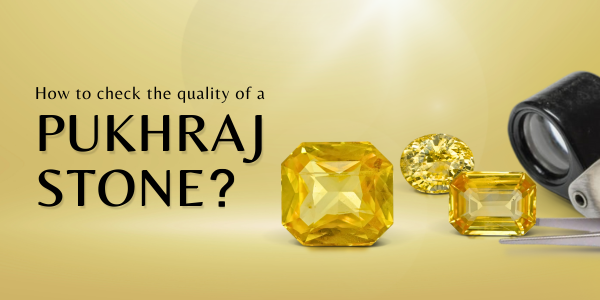
HOW TO CHECK THE QUALITY OF A PUKHRAJ?
Are you looking to purchase a Pukhraj Stone but not sure how to determine its quality? You're not alone. With the increasing popularity of this gemstone, it's important to know how to check its authenticity and make sure you're getting your money's worth. In this blog post, we'll be discussing How to check the quality of Pukhraj Stone. Whether you're a first-time buyer or an experienced gem collector, this guide will help you make an informed decision and ensure you're getting a high-quality Pukhraj Stone.
Read more
PRECAUTIONS TO FOLLOW AFTER WEARING PUKHRAJ (YELLOW SAPPHIRE)
Pukhraj, also known as Yellow Sapphire, is a highly valued gemstone in Vedic astrology. It is believed to bring prosperity, success, and good fortune to its wearer. However, like any other gemstone, it is important to take certain precautions after wearing Pukhraj to ensure that it works effectively and does not bring any negative impacts. In this blog, we will discuss the necessary precautions that should be taken after wearing Pukhraj to harness its positive energies and avoid any potential harm.
Read more
YELLOW SAPPHIRE - THE SEPTEMBER BIRTHSTONE
Welcome to our blog post about the September birthstone - the yellow sapphire! This gorgeous gemstone has been cherished for centuries for its vibrant yellow hue and mystical properties. If you or a loved one were born in September, you are in luck as the yellow sapphire is your designated birthstone. In this post, we will dive into the history, meanings, and benefits of this beautiful gem, and why you should consider buying a yellow sapphire for yourself or as a gift for someone special. So, let's get started and discover the wonders of the yellow sapphire!
Read more
DIFFERENCE BETWEEN YELLOW SAPPHIRE & CITRINE
Yellow sapphire and citrine are two popular gemstones that are often confused due to their similar appearance. Both stones have a vibrant yellow color and are known for their beauty and healing properties. However, despite their similarities, yellow sapphire and citrine are two distinct gemstones with different origins, compositions, and meanings. In this blog post, we will delve into the differences between yellow sapphire and citrine, exploring their unique characteristics and symbolism. Whether you are a gemstone enthusiast or simply looking to learn more about these stunning stones, this article will provide you with a deeper understanding of the distinct qualities and energies of yellow sapphire and citrine. So, let's dive in and discover the differences between these two striking gemstones.
Read more




















Comments (0)